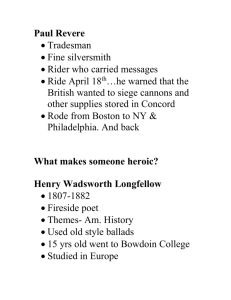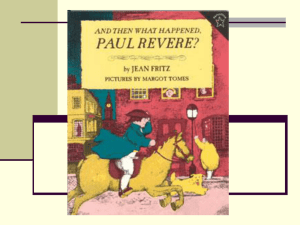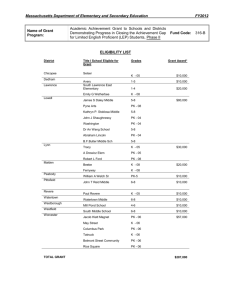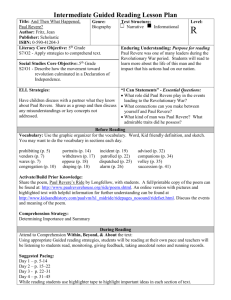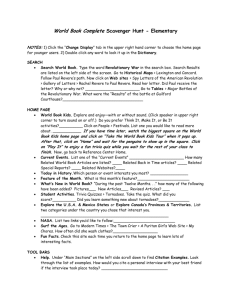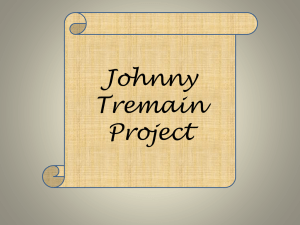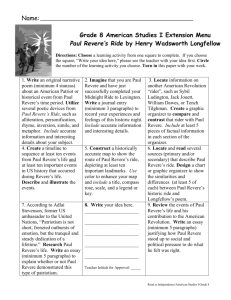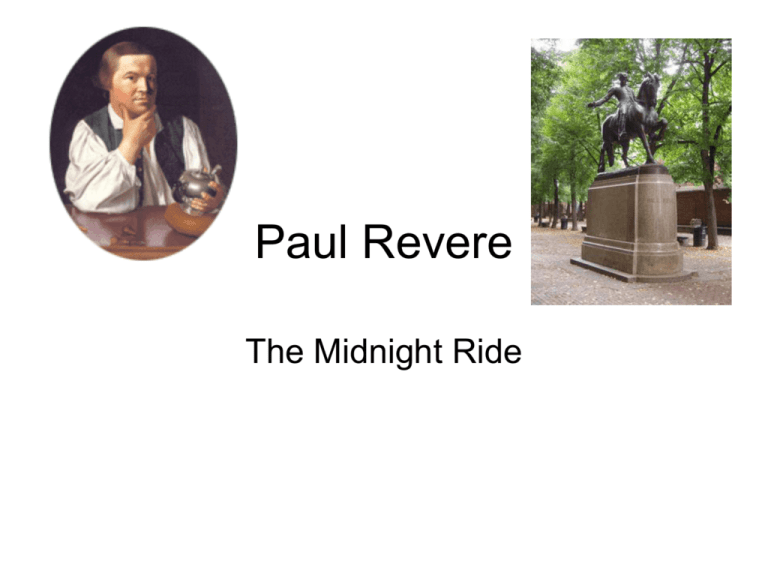
Paul Revere
The Midnight Ride
Make a list of
facts about
Paul Revere
that you already
know
Add to your list
of facts about
Paul Revere as
you go through
this lesson
• Henry Wadsworth Longfellow's poem Paul Revere's
Ride, written in 1860 and published in 1861 in the
Atlantic Monthly, transformed Paul Revere from a
relatively obscure, although locally known, figure in
American history into a national folk hero. As a result,
most people know him only for his famous ride to
Lexington on the night of April 18-19, 1775. Revere's life,
however, was a long and productive one, involving
industry, politics, and community service.
• Click here for more details on Revere's ancestry and
family. http://www.paulreverehouse.org/bio/father.html
Revere's Early Life
• Born in Boston's North End in December, 1734, Paul Revere was the son
of Apollos Rivoire, a French Huguenot (Protestant) immigrant, and
Deborah Hichborn, daughter of a local artisan family. Rivoire, who
changed his name to Paul Revere some time after immigrating, was a
goldsmith and eventually the head of a large household. Paul Revere
was the second of at least 9, possibly as many as 12 children and the
eldest surviving son.
• Paul was educated at the North Writing School and learned the art of gold
and silversmithing from his father. When Paul was nineteen (and nearly
finished with his apprenticeship) his father died, leaving Paul as the
family's main source of income. Two years later, in 1756, Revere
volunteered to fight the French at Lake George, New York, where he was
commissioned as a second lieutenant in the colonial artillery.
• In August, 1757, Revere married Sarah Orne. Together, they had eight
children. Soon after Sarah's death in 1773, Revere married Rachel
Walker with whom he had eight children.
• Click here for more details on Revere's Family and Ancestry
http://www.paulreverehouse.org/bio/father.html
Revere Silversmith / Craftsman
• Revere's primary vocation, a trade he learned from his father, was that of
goldsmith/silversmith, meaning he worked in both gold and silver. His
silvershop was the cornerstone of his professional life for more than 40
years. As the master of his silversmith shop, Revere was responsible for
both the workmanship and the quality of the metal alloy used. He
employed numerous apprentices and journeymen to produce pieces
ranging from simple spoons to magnificent full tea sets. His work, highly
praised during his lifetime, is regarded as one of the outstanding
achievements in American decorative arts.
• Revere also supplemented his income with other work. During the
economic depression before the Revolution, Revere began his work as a
copper plate engraver. He produced illustrations for books and
magazines, business cards, political cartoons, bookplates, a song book
and bills of fare for taverns. He also advertised as a dentist from 1768 to
1775. He not only cleaned teeth, but also wired in false teeth carved from
walrus ivory or animal teeth. Contrary to popular myth, he did not make
George Washington's false teeth. Fabricating a full set of dentures was
beyond his ability.
Political Activities / Revolutionary War
• Revere's political involvement arose through his connections with
members of local organizations and his business patrons. As a member
of the Masonic Lodge of St. Andrew, he was friendly with activists like
James Otis and Dr. Joseph Warren. In the year before the Revolution,
Revere gathered intelligence information by "watching the Movements of
British Soldiers," as he wrote in an account of his ride. He was a courier
for the Boston Committee of Correspondence and the Massachusetts
Committee of Safety, riding express to the Continental Congress in
Philadelphia. He also spread the word of the Boston Tea Party to New
York and Philadelphia.
• At 10 pm on the night of April 18, 1775, Revere received instructions from
Dr. Joseph Warren to ride to Lexington to warn John Hancock and
Samuel Adams of the British approach. The war erupted and Revere
went on to serve as lieutenant colonel in the Massachusetts State Train
of Artillery and commander of Castle Island in Boston Harbor. Revere and
his troops saw little action at this post, but they did participate in minor
expeditions to Newport, Rhode Island and Worcester, Mass. Revere's
rather undistinguished military career ended with the failed Penobscot
expedition.
Paul Revere Industrialist - Post War
Businesses
•
Revere expanded his business interests in the years following the Revolution. He
imported goods from England and ran a small hardware store until 1789. By 1788
he had opened a foundry which supplied bolts, spikes and nails for North End
shipyards (including brass fittings for the U.S.S. Constitution), produced cannons
and, after 1792, cast bells. One of his largest bells still rings in Boston's Kings
Chapel.
•
Concerned that the United States had to import sheet copper from England,
Revere opened the first copper rolling mill in North America in 1801. He provided
copper sheeting for the hull of the U.S.S. Constitution and the dome of the new
Massachusetts State House in 1803. Revere Copper and Brass, Inc., the
descendent of Revere's rolling mill is best known for "Revereware" copperbottomed pots and pans. Revereware is now, however, manufactured by another
company.
•
Revere's community and social involvements were extensive. He was a
Freemason from 1760 to 1809 and held several offices in St. Andrew's and Rising
States Lodges as well as the Massachusetts Grand Lodge. A member of the
Massachusetts Charitable Mechanics Association, Revere also served as the
association's first president. Founded in 1794, the group was an organization of
artisans, and small businessmen who sought to improve the conditions under
which their peers worked and aided members in "distressed" circumstances.
Last Years
• In 1811, at the age of 76, Paul Revere retired and
left his well-established copper business in the hand
of his sons and grandsons. Revere seems to have
remained healthy in his final years, despite the
personal sorrow caused by the deaths of his wife
Rachel and son Paul in 1813. Revere died of
natural causes on May 10, 1818 at the age of 83,
leaving five children, several grandchildren and
great-grandchildren. The son of an immigrant
artisan, not born to wealth or inheritance, Revere
died a modestly well-to-do businessman and a
popular local figure of some note. An obituary in the
Boston Intelligence commented, "seldom has the
tomb closed upon a life so honorable and useful."
Paul Revere is buried in Boston's Granary Burying
Ground.
Source of Biography
• http://www.paulreverehouse.org/bio/
• Copyright © 1997-2007, Paul Revere Memorial
Association. All rights reserved. Site design by
The Worx Group, Prospect, CT.
Do you believe that
Paul Revere would
be remembered
today if he had
never been on his
famous ride?
Yes/No
Why or Why not?
The Midnight Ride
• Read the accounts on the class website
about Paul Revere’s ride
– Account D and E
– Account C (it is longer however)
• Click here for a complete description,
including map and images.
– http://www.paulreverehouse.org/ride/real.html
• Link to events in Paul Revere’s own
words:
• http://www.masshist.org/cabinet/april2002/
reveretranscription.htm
Popular Imagery of Paul Revere and His Ride
Popular Imagery of Paul Revere and His Ride
Paul Revere’s Ride Summary
April 18/19, 1775
Paul Revere
•Charlestown,
across water
“Regulars are
coming!”
Not: “British are
coming!”
William Dawes
Dr. Joseph Warren
sends riders to
warn John Hancock
and Samuel Adams
•Boston Neck, by
land
Henry Wadsworth Longfellow
• 180701882
• Portland, ME
• 1st American with a
memorial bust in Poets’
Corner at Westminster
Abbey
• Paul Revere’s Ride
– Written April 19, 1860
– First published in The
Atlantic Monthly in January,
1861
– Later published in 1863 as
part of "Tales of a Wayside
Inn"
Links to Paul Revere’s Midnight Ride
Use one of the following links to listen to an account
of Paul Revere’s Midnight Ride based on
Longefellow’s poem:
• http://www.npr.org/templates/story/story.php?story
Id=1231017
• http://youtu.be/U4hUMQG3MI8
Text of poem
• http://www.nationalcenter.org/PaulRevere's
Ride.html
Flowing Metre anapestic tetrameter = galloping of a horse
Create a Venn Diagram of Longfellow’s Account
of Paul Revere and the Other Sources
Why Do We Remember Revere the Way We Do?
•
Rank the following hypotheses from 1 to 9, with 1 being the most likely reason
and 9 being the least likely. (Use each number once.)
•
•
_____ Because it was a very important event in the American Revolution.
_____ Because the event occurred on the first day of fighting in the American
Revolutionary War.
_____ Because Revere demonstrated exceptional bravery and resourcefulness.
_____ Because Longfellow’s poem became very well known and famous.
_____ Because people started telling the story to their children and it was passed
down through the generations.
_____ Because Revere was already such a well known personality due to his
support of the patriot’s cause as well as his fine silversmith work.
_____ Because within the event were many images that people remember, for
example, the Red coats — even if Revere never actually said, “The Red coats are
coming”; “two if by sea”) that have become important national symbols.
_____ Because in 1861, at the time the poem was published, the nation had a
need for something to help unify it.
_____ Because in 1861, at the time the poem was published, few were alive who
had first-hand knowledge of the event and people were nostalgic for the “good old
days.”
•
•
•
•
•
•
•
•
Would you add any reasons of your own? If yes, what? Where would you rank
your reason?
'Tis all very well for the children to hear
Of the midnight ride of Paul Revere;
But why should my name be quite forgot,
Who rode as boldly and well, God wot?
Why should I ask? The reason is clear—
My name was Dawes and his Revere.
Concord Hymn
By the rude bridge that arched the flood,
Their flag to April's breeze unfurled,
Here once the embattled farmers stood,
And fired the shot heard round the world.
The foe long since in silence slept;
Alike the conqueror silent sleeps;
And Time the ruined bridge has swept
Down the dark stream which seaward creeps.
On this green bank, by this soft stream,
We set to-day a votive stone;
That memory may their deed redeem,
When, like our sires, our sons are gone.
Spirit, that made those heroes dare
To die, and leave their children free,
Bid Time and Nature gently spare
The shaft we raise to them and thee.
from: Emerson, Ralph Waldo. Early Poems of Ralph Waldo Emerson. New York,
Boston, Thomas Y. Crowell & Company: 1899.

